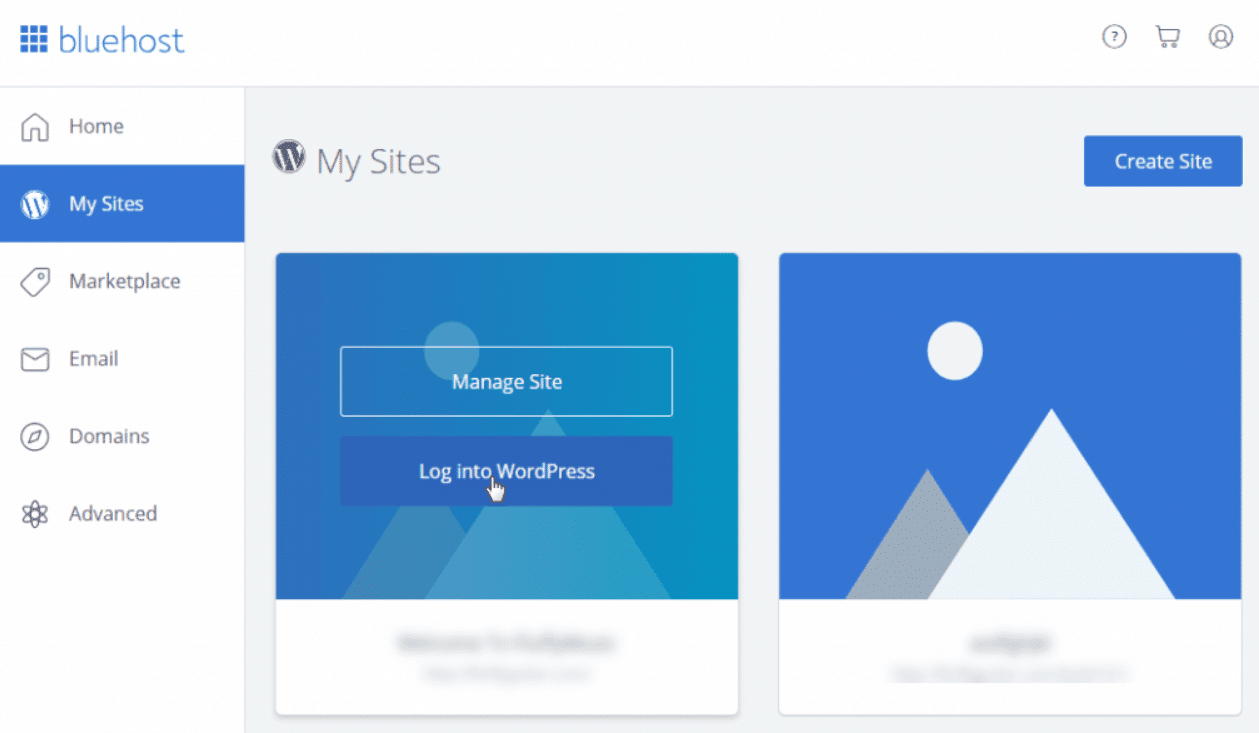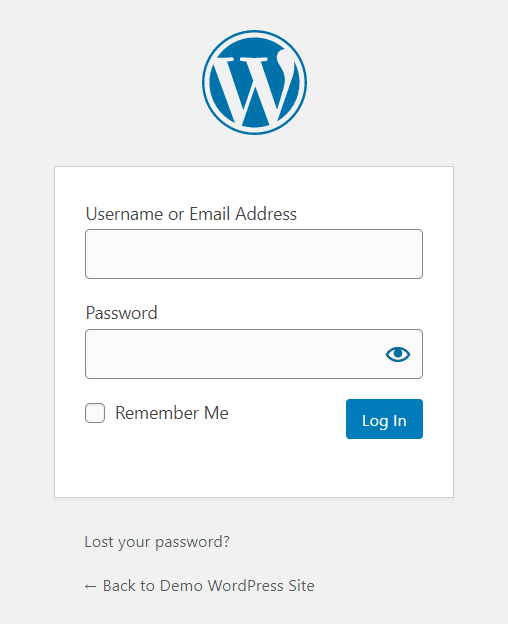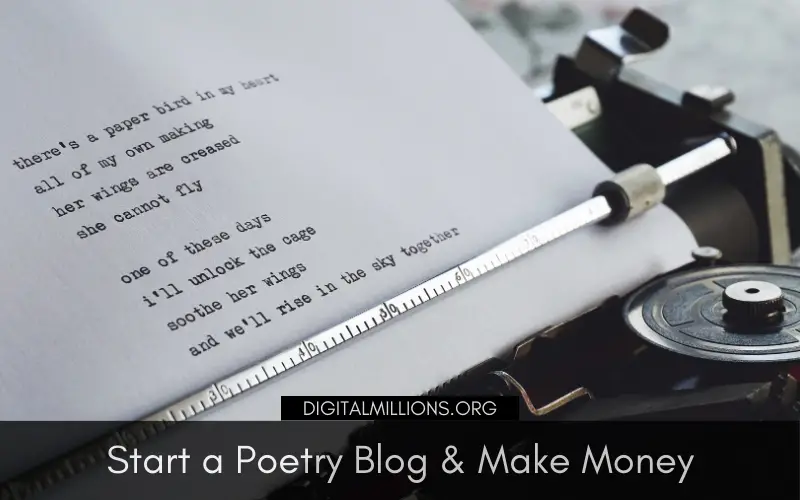Are you looking for a way to turn your passion for poetry into a profitable venture? Do you dream of starting your own poetry blog and making money online?
If so, you’re in the right place!
Starting a blog may seem like a daunting task if you’ve never done it before.
But, it’s easier than you might think.
With a little bit of effort and creativity, you can create a platform to showcase your work and connect with other poetry enthusiasts, while earning some extra cash.
In this post, I’m going to take you through the step-by-step process of starting a poetry blog and make money from it. We’ll cover everything from choosing a domain name and hosting platform to promoting your blog and monetizing it.
So, if you’re just starting out, this guide will give you the info you need.
But why you should start a poetry blog in the first place.
Poetry is a powerful form of self-expression that can connect us with others on a deep emotional level. By starting a poetry blog, you have the opportunity to share your work with a wider audience, while also building a community.
But it’s not just about the art.
With the rise of the digital age, blogging has become a lucrative industry. By monetizing your poetry blog, you can turn your passion into a profitable side hustle or even a full-time career. Imagine earning money doing what you love most.
So, without further delay, let’s get started on this exciting journey!
Define Your Niche and Target Audience
What is a niche, you ask?
It’s not just some buzzword thrown around by online marketers, but rather a crucial element of success for any blogger or content creator.
Your niche is the specific topic or area of interest.
This is something you will focus on in your blog, and your target audience is the group of people who will be most interested in what you have to say.
Choose a Specific Niche
Now, I know what you’re thinking –
“But I’m a poet, I don’t need to worry about niches and target audiences!”
Well, I’m here to tell you that even poets need to have a clear understanding of their niche and target audience if they want to create a successful poetry blog.
Your niche can be anything from love poetry to slam poetry to haikus about nature. The key is to choose a niche that you are passionate about and that sets you apart from other poets. You want to be known as the go-to poet for your specific niche.
So, it’s important to choose something that you are truly passionate about and that you have a unique perspective on.
Once you have identified your niche, it’s time to think about your target audience.
Define Your Target Audience
Who are the people that are most likely to be interested in your poetry?
Are they young adults searching for love poetry, or nature enthusiasts looking for haikus about the outdoors? Once you have a clear understanding of your target audience, you can tailor your content to meet their specific needs and interests.
So how do you go about defining your niche and identifying your target audience? Well, the first step is to do your research. Spend some time reading other poetry blogs and analyzing what makes them successful. What topics do they focus on? Who is their target audience? What sets them apart from other poets?
Once you have a good understanding of what’s already out there, it’s time to start brainstorming ideas for your own niche.
Think about what topics you are most passionate about and what sets you apart from other poets. Do you have a unique perspective on love poetry?
The more specific and focused your niche, the better.
When it comes to identifying your target audience, think about who you want to reach with your poetry. Are you writing for a specific age group or demographic? Do you want to appeal to a certain interest group, such as nature enthusiasts or music lovers?
The more specific you can be in defining your target audience, the easier it will be to create content that resonates with them.
Examples of Poetry Niches
Here are some examples of niches that a poetry blog could focus on:
- Love poetry
- Nature and environmental poetry
- Social justice poetry
- Political poetry
- Poetry about mental health
- Haikus about daily life
- Humorous poetry
- Poetry inspired by music
- Inspirational poetry
- Poems about spirituality and religion
These are just a few examples to get you started.
But, the possibilities are endless.
Choose a Platform for Your Blog
In order to start a blog, you’ll need a blogging platform.
These are online platforms or software that you can use to write and publish your blog posts, whether it’s a personal blog, a business blog, or anything in between.
Some popular options include:
- Blogger
- WordPress.com
- Tumblr
- Medium
- Ghost
So, there are many options.
But, one that stands out is WordPress – self hosted version.
What is WordPress and How it Works?
WordPress is 100% free and open-source CMS (content management system).
It’s used by millions of websites worldwide. It was originally designed as a blogging platform, but has since evolved into a full-fledged website builder.
WordPress offers users the flexibility to create any type of website they desire, from a simple blog to a complex e-commerce site. It is easy to use, customizable, and offers a vast library of plugins and themes to enhance its functionality.
Why Choose WordPress for Your Blogging Site?
Well, it’s incredibly user-friendly.
You don’t need any special knowledge to use WordPress.
The platform is designed to be intuitive, so even beginners can create a website with ease. WordPress also offers a wide range of customization options.
Whether you want to change the design, add new features, or optimize your site for search engines, WordPress has a plugin or theme that can help.
Another key benefit of using WordPress is its scalability.
You can start with a simple blog and as your needs grow, you can easily add new features and functionality to your website. This means you don’t have to worry about outgrowing your blogging platform.
One of the main reasons why WordPress is so popular is its vast library of plugins and themes. Plugins are small software add-ons that you can add to your site to add new features and functionality. There are over 60,000 plugins available for WordPress, so you can easily find one that suits your needs.
Themes, on the other hand, are pre-designed WordPress templates that you can use to change the look and feel of your website. WordPress has thousands of themes available, so you can easily find one that matches your style and brand.
But perhaps the most compelling reason to choose WordPress is its community.
WordPress has a massive community of users and developers who are constantly creating new plugins, themes, and resources.
It means you can always find help when you need it, whether it’s through the WordPress support forums, online tutorials, or social media groups.
In short, if you want to start a blog or website, WordPress is the way to go. It’s easy to use, customizable, scalable, and has a massive community of users and developers. So, whether you’re a beginner or an experienced blogger, WordPress has everything you need to create a successful online presence.
The blog you are reading righ now is also built on WordPress CMS.
So, in this post, I’ll show you how to create a WordPress blog.
Choose Hosting and a Domain Name
Even though WordPress is free to use, you can’t build a website with only WordPress. You’ll also need a domain name and hosting to host your website.
Don’t worry, it’s not as difficult as it may sound!
First, let’s talk about the importance of a domain name.
Every website needs a domain.
It’s the website address that people type to visit your site.
Your domain name is essentially the identity of your blog. It’s the name that people will remember when they want to visit your site.
How to Choose a Domain Name?
When choosing a domain name for your poetry blog, you want to make sure that it’s short, easy to remember, and relevant to your blog’s content. Your domain name should also be unique and not already taken by another website.
Think of something creative and unique that represents your poetry.
Once you’ve chosen your domain name, it’s time to select a hosting provider.
Hosting is essentially the space on the internet where your website will live.
The Best Web Hosting Service for Beginners
There are many web hosting service providers out there.
But Bluehost is the best option for beginners.
Why?
Because it’s incredibly easy to use and comes with great features like one-click WordPress installation and 24/7 customer support.

Bluehost also offers affordable pricing plans that won’t break the bank.
One of the best things about Bluehost is that it’s optimized for WordPress, which is the most popular blogging platform, as already discussed before.
With Bluehost, you can install WordPress effortlessly, and you’ll be ready to start working on customizing your blog in no time.
So, now you know you need a domain and Bluehost to get started.
Let’s see how to buy hosting and get your blog ready.
Setting Up Your WordPress Blog
First, you need to buy hosting for your blog.
Here’s a step-by-step process on how to buy hosting from Bluehost:
- Go to Bluehost’s website and click on the “Get Started” button.
- Choose the hosting plan that best suits your needs.
- Choose whether you want to register a new domain name or use an existing one.
- Select the duration of your plan (12 months, 24 months, or 36 months).
- Fill in your personal and billing information.
- Review your order details and complete your purchase.
- Once paid, you’ll be able to create a password for your Bluehost account and you’ll be able to login to your account and access WordPress.
Bluehost automatically installs WordPress in the background when you sign up, so you don’t need to worry about doing it yourself.
Once you’ve logged in to your Bluehost account, you’ll be able to access your WordPress dashboard and start customizing your website.

Congratulations!
WordPress is now installed and you are ready to set it up. So, let’s dive into setting up and configuring your WordPress blog step by step!
Step 1: Log in to your WordPress Dashboard
To access your WordPress Dashboard, type in your website’s domain name followed by /wp-admin/ in your browser.
For example, www.yourdomain.com/wp-admin/.

Enter your username and password, and click on the ‘Log In‘ button.
Step 2: Choose a Theme for Your Blog
The look and feel of your blog are essential.
And, the theme is responsible for that. Your theme should be simple, easy to navigate, and visually appealing to your readers.
You can browse through WordPress’s vast collection of over 10,000 free and premium themes, or you can purchase a theme from a third-party website.
Once you have chosen a theme, install and activate it.
Step 3: Install Plugins
Plugins are like apps that add extra functionality to your blog.
There are over 60,000 plugins available for WordPress.
So, make sure to choose wisely.
Some popular plugins include Yoast SEO, Jetpack, Contact Form 7, and Akismet. These WordPress plugins can help you optimize your blog for search engines, add social sharing buttons, protect your blog from spam, and a lot more.
Read – 55+ Best WordPress Plugins You Need to Know
Step 4: Create Essential Pages
Once you have your theme and plugins set up, it’s time to create some content.
Your blog needs two essential pages: an ‘About’ page and a ‘Contact’ page.
You can create new pages by going to Pages > Add New.

Next, create an About page that tells your readers who you are, what your blog is about, and what they can expect from your content.
On the Contact page, add a contact form or your email address.
Step 5: Configure Your Settings
The WordPress Dashboard has a lot of settings to configure, but don’t worry, you don’t have to go through all of them. Some of the essential settings to configure include Permalinks, Comments, and Privacy. In order to access your settings, go to Settings > General, Settings > Permalinks, and Settings > Discussion.
You’ll find complete guide here: Complete WordPress Setup Guide
Step 6: Customize Your Blog
Lastly, customize your blog to make it stand out from the rest.
You can add a custom header image, change your blog’s background, and add widgets to your sidebar or footer. To customize your blog, go to Appearance > Customize.
Step 7: Start Creating Content
Now that you have your blog set up and essential pages created, it’s time to start creating content or writing poetry for your blog. Creating a blog post in WordPress for a poetry blog is similar to creating a post for any other type of blog.
Here are the steps to create a blog post for a poetry blog in WordPress:
- Click on the “Posts” tab on the left-hand side of the dashboard.
- Click on the “Add New” button to create a new post.
- Give your blog post a title that reflects the content of your poem.
- In the main content area, write your poem.
- Use the WordPress editor to format the text of your poem. You can also use the editor’s built-in tools to add images, videos, or audio files to your post.
- Consider adding a featured image that reflects the mood or theme of your poem. This image will appear as the thumbnail for your blog post on your blog’s homepage and other archive pages.
- Add tags and categories to your blog post. This will make it easier for readers to find your poem and other related content on your blog. For example, you might use tags like “love poetry,” “nature poetry,” or “sonnets.”
- Preview your blog post to make sure everything looks the way you want it to.
- When you’re ready, click the “Publish” button to make your poem live on your blog.
So, as you can see, with the above-mentioned steps, you can create a blog that is not only visually appealing but informative and engaging as well.
Make sure to stay consistent with your content creation and post regularly.
Create Engaging Content for Your Poetry Blog
If you’re passionate about poetry, then you know that it’s a beautiful way to express emotions and connect with others.
But with so many poetry blogs out there, how can you make yours stand out? The answer is simple – create poetries that engage and inspire your readers.
The Importance of Quality Content
First, you need to understand the importance of quality content.
In today’s digital age, where there’s an endless supply of information available, it’s really essential to create poetry content that stands out from the rest. Your poetry blog must offer something unique and valuable that your readers can’t find anywhere else.
Furthermore, your content will help establish you as an authority in the poetry niche. This will help you attract more readers and grow your blog’s traffic.
Tips for Creating Engaging Poetry Content
Now, let’s explore some tips for creating engaging poetry content that will keep your readers coming back to your blog for more.
- Find Your Unique Voice: When it comes to writing poetry, your voice is your unique selling point. It’s what makes your content stand out from the rest. So, find your unique voice and use it to express yourself.
- Use Emotional One-Liners: One-liners are a great way to express a strong emotion. They’re impactful, memorable and can leave a lasting impression.
- Use Strong Imagery: Imagery is a crucial element of poetry, and it can make your content more engaging and memorable. Use strong, vivid images to paint a picture in your readers’ minds and evoke emotions.
- Experiment with Different Forms and Styles: Don’t be afraid to experiment with different forms and styles of poetry. Try haikus, sonnets, free verse, and other forms to keep your content fresh and interesting.
By following these tips and types of content, you can create a blog that stands out from the rest and becomes a go-to resource for poetry lovers.
So, go ahead and start writing from your heart, and let your emotions flow.
Promote Your Poetry Blog
Simply creating a poetry blog is not enough. You need to promote it effectively to reach a wider audience and make an impact in the poetry community.
Start with SEO or search engine optimization.
Use SEO
Search engine optimization is crucial because it helps your blog rank higher in search results, making it easier for people to find and read your poetry.
By conducting proper keyword research and implementing appropriate SEO techniques, you can increase traffic to your blog and improve your visibility on search engines like Google and Bing. Start with a free site audit at SEMrush.
Social Media Platforms
Another effective way to promote your poetry blog is to engage with your readers through social media platforms such as Twitter, Facebook, and Instagram.
Social media provides a great opportunity to connect with like-minded individuals, share your poetry, and promote your blog. By regularly posting on social media, you can build a loyal audience and drive traffic to your blog.
Guest Blogging
Guest blogging is another effective way to promote your poetry blog. You can reach out to other poetry bloggers or literary magazines and offer to write a guest post for them. This is a great way to reach a wider audience, establish yourself as an authority in the poetry community, and build relationships with other poets and bloggers.
Finally, it is important to consistently produce high-quality poetry content on your blog. Your poetry should be authentic, heartfelt, and engaging.
Monetize Your Poetry Blog
Monetizing your poetry blog can be a difficult task, but it is not impossible. If you want to monetize your poetry blog, there are several methods you can use.
Affiliate marketing
You don’t have to sell your soul to make money from your blog.
Instead, you can simply partner with brands and products that offer affiliate programs and products that can be valuable for your readers.
As an affiliate marketer, you’ll earn a commission for every sale made through your unique referral link. This way, you can recommend products you genuinely love and use, such as books, writing tools, or even merchandise with your own poetry on it!
Read- The Ultimate Guide to Make Money with Affiliate Marketing
Place Ads on Your Blog
Let’s face it, advertisements can be annoying.
But, they can also be an effective way to generate revenue.
You can sign up with advertising networks like Google AdSense, Ezoic, or Mediavine, which will place relevant ads on your blog.
The more traffic your blog gets, the more money you’ll earn. But be careful not to clutter your site with too many ads, as it can turn off your readers.
Sponsorships
If you have a loyal following, you can also offer sponsorship opportunities to brands or businesses that align with your brand.
For example, you can partner with a local bookstore for a poetry reading event, or collaborate with a writing coach to offer a workshop for your readers. In return, you’ll receive a fee or other benefits, such as exposure or free products.
Self-publishing
As a poet, you have the advantage of being able to self-publish your work and sell it directly to your audience. You can create e-books, print-on-demand paperbacks, or even audiobooks of your poetry. You can also offer exclusive content, such as unpublished poems or behind-the-scenes insights, to your subscribers or patrons.
So, as you can see, there are many ways to monetize your poetry blog, and the key is to find the right balance between creativity and profitability.
Remember to stay true to your voice and style, and always prioritize the needs and interests of your audience. As you explore these methods, you’ll find that making money from your passion is not only possible but also fulfilling.
Final Words and Thoughts
In conclusion, starting a poetry blog can be a fulfilling and rewarding experience for anyone with a passion for writing and a love of poetry.
With the tips and advice outlined in this post, you can set yourself up for success.
Always keep the joy and wonder of poetry at the heart of your blog.
With patience, persistence, and creativity, your poetry blog can become a thriving online community where you can share your art, connect with others, and inspire readers around the world. So go ahead and start your poetry blog today.
And, if you’ve found this post useful, please share it.

